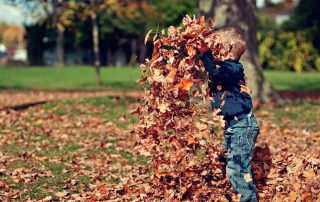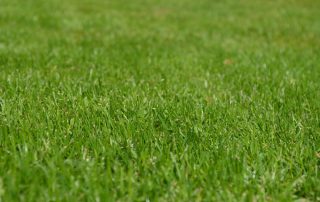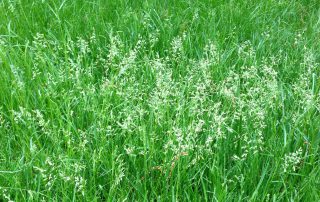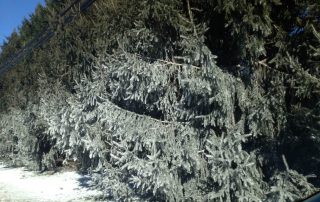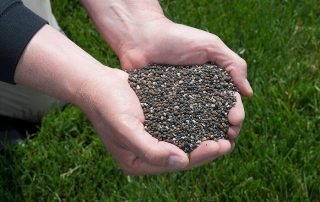Frequently Asked Questions
Are the lawn, tree, and shrub products you use safe for the environment and pets?
The products we use require thorough testing by EPA and other federal and state agencies. Lawn care professionals know to apply the products at the proper label rates and use the least amount possible to obtain good results.
How long after a treatment can I let my children and pets play on the lawn?
Generally, we recommend that you keep children and pets off of the lawn for a couple of hours after a liquid treatment.
How long after a lawn, tree, or shrub treatment will I see results?
You should see results 2 – 3 weeks after the first lawn, tree, or shrub treatment, as long as the weather conditions are conducive to optimizing the treatment.
Do you offer an organic program or all-natural treatments?
We do not have a 100% organic program since there are no organic controls for crabgrass and broadleaf weeds that give commercially acceptable results. However, in our fertilizers we do use an organic base and are offering a bio-stimulant treatment to help root hardness.
When is the best time to seed my lawn?
Fall is the best time to aerate and seed lawns in our area since soil and air temperatures are optimum for germination and lawn establishment. In addition, lawn seeding is ideal in the fall since there is less weed competition at that time.
Why does my lawn need soil testing?
For one reason, the Maryland Department of Agriculture requires that all professional lawn care companies conduct a soil test on their customer’s property within one year of commencement of any fertilization treatment program. Also, it is important on an agronomic level that we know what the condition of your soil is to make our best recommendations for your lawn’s health.
Do you have anything to control moles and voles in my lawn?
There are no good chemical means to control moles or voles. However, there are many home remedies that can help reduce the population of moles in your lawn.
How often should I aerate my lawn?
Soils in central Maryland usually contain a large amount of clay. This soil type becomes compacted from foot and mower traffic, especially in wet years and on irrigated turf. Also, turf that is thatchy benefits from aeration. Heavily compacted and/or thatchy lawns should be aerated every year. Less compacted/thatchy lawns can be aerated less often.
Do you offer other services that will further improve my lawn’s health?
We offer lawn, tree and shrub treatments to prevent and control grubs and other turf damaging insects. We also offer lawn disease control to keep your grass healthy and green. In addition, we provide supplemental nutrient treatments and can apply a nutrient or soil amendment such as phosphorus, potassium, and limestone if your soil sample results demonstrate a need.
I live in an area that is prone to deer and am concerned about Lyme disease. Do you have lawn, tree, or shrub treatments for deer tick control?
We do offer a flea and tick program that helps to minimize ticks in the lawn and landscape beds. It will also help protect your dog from fleas and other types of ticks.
Do you offer services for pests that enter the house?
We do have a perimeter pest program that helps to minimize the many soil pests that can enter the house through the foundation. Such pests are ants, ticks, fleas, earwigs, pillbugs and crickets.
Watch Us In Action
Read All About It
Fall Lawn Care Tips
Taking care of your lawn doesn't stop when the weather cools and the leaves begin to change color. Fall is an important time for turf to “heal” after a stressful summer, especially if it has been worn down by traffic or suffered from disease or insect problems. Not only can you repair summer damage to the lawn [...]
Lawn Seeding
If you are frustrated with a thin and bare lawn, you should consider late-season lawn seeding! Late summer is the ideal time to decide if your lawn needs seeding work for the upcoming year. Careful advanced planning and follow-up of lawn seeding can determine the success or failure of your lawn seeding. We have a limited time [...]
Seedheads in Lawns
If you look closely at your lawn this time of year, you may think it is full of weeds. But in reality, it could be a natural phenomenon that occurs in many turfgrasses in the spring called inflorescence - or flowering and seedhead production. Unfortunately, an abundance of seedheads can make a lawn look unattractive and the [...]
Tree & Shrub Salt Damage
Injury due to salt is most common on landscape plants growing adjacent to highways, streets, sidewalks, and driveways that are regularly salted during the winter for ice control. Most of the salt used for deicing purposes is sodium chloride, ordinary rock salt or table salt. On highways, the major problem to plants is caused by salt [...]
Limestone Benefits for Lawns
Limestone Benefits Limestone benefits your lawn in many ways. When your soil pH is too low or acidic, it needs limestone to bring it back into balance. Soil that is too acidic causes fertilizers and important nutrients to become 'locked up' and thus unavailable to the grass plant. Locked up nutrients may result in the grass [...]


